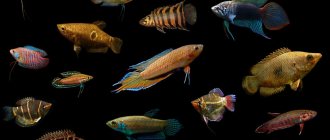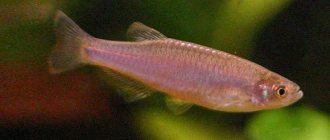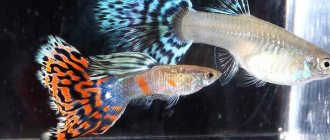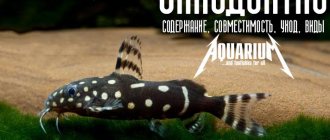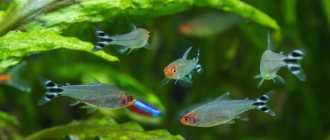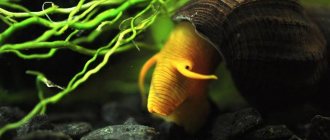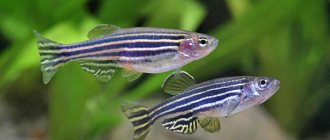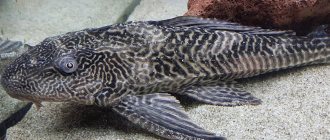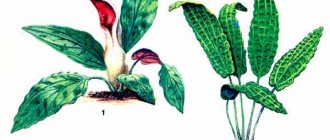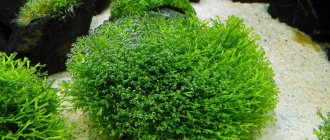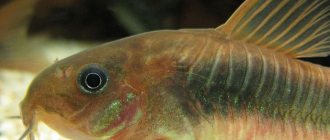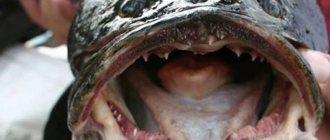Cyphotilapia Frontosa is a very unusual member of the Cichlidae family, popular with many aquarists. It has an impressive size and a bright striped color, which invariably attracts the attention of others. But it is worth knowing that when bred at home, it can become not only a beautiful pet, but also a dangerous predator for some fish.
- 1 Description and natural habitat
- 2 Mr. Tail recommends: variety of species
- 3 Basics of aquarium keeping
- 4 Compatibility
- 5 Feeding
- 6 Breeding
- 7 Diseases and prevention
- 8 Interesting facts
Description
Frontosa fish occupies one of the leading positions in size among cichlids. Adults in captivity grow to 18–26 cm.
- The body is elongated oval.
- The head is big.
- Fatty growth in the frontal lobe is pronounced in both sexes.
- The end of the dorsal fin is elongated.
- Finite type mouth.
- The lower jaw is able to move forward.
- The eyes are large and deep set. With age, the eyeballs protrude forward.
The lifestyle is gregarious. It is recommended to keep in a group of 2-4 individuals.
Appearance
Adult fish attract attention with their gloomy and at the same time studying gaze. This feature is given to the fish by a large frontal growth. Color is a distinctive feature of this species of cyphotilapia.
Exterior description:
- The first line runs before the beginning of the dorsal plumage.
- The last stripe extends in front of the caudal fin.
- The edging of the dorsal fin is turquoise blue or golden.
- The ventral plumage is light blue.
- The anal and dorsal fins are azure or pervanche.
Behavior
Unlike other representatives of the cichlid genus, representatives of this species are peaceful and slow.
Distinctive character traits:
- Slowness. Especially during meals.
- Shyness often manifests itself during the spawning period in females.
- Predisposition to stress.
- Aggression is mainly of a territorial type.
- Changes in habitat are difficult to tolerate.
- A hierarchical ladder develops within the pack.
How do your frontoses behave?
Lifespan
In their natural environment, cyphotilapia survive no more than 8–15 years. This is due to the large population of these fish in the lake and high competition within the school. In aquarium conditions, the lifespan of cyphotilapia increases by 1.5–2 times and reaches 20–25 years.
Interesting Facts
Tanganyika, like Baikal, is a large and ancient aquatic ecosystem that is part of the African Great Lakes group. Of great interest is the lake itself, where fish live naturally.
Lake Tanganyika - habitat of frontosa
It is believed that its name translates to “water reservoir full of fish.” It is difficult to describe Tanganyika more precisely, since its waters are home to more than 200 species of rare fish. The vast majority of them are endemic and are not found anywhere else in nature. This biological diversity is associated with another amazing fact - the lake has never dried up throughout its existence.
The Queen of Tanganyika fish itself attracts a lot of attention and surprises with its behavior:
- over time, frontoses get used to the owner and begin to take food from hands and allow themselves to be stroked;
- the gaze of an adult can make a person reconsider his attitude towards fish; at first he seems very gloomy, then studying and as if comprehending everything that is happening around him;
- due to the movable lower jaw, the lobed cyphotilapia can absorb food at some distance, pulling it into the huge mouth remotely;
- the saturation of the black stripes on the body depends on the mood of the fish;
- During spawning, males of some varieties acquire a steel color and become monochromatic.
With age, in frontoses, the fatty growth increases, and the color becomes darker.
Kinds
The main characteristics by which cyphotilapia differ by species are color forms:
- Kavala. The connecting partitions of the dorsal plumage are yellow.
- Moba. Bright blue tint throughout the body.
- Kigoma. The membrane of the dorsal plumage is yellow. 6 lines. The first stripe begins under the eyes.
- Mpimbwe. 6 lines. Ultramarine color. The sixth stripe ends above the eye sockets.
- Burundi. The body is azure or lunar in color. 6 stripes.
- Zaire. 5 lines that do not run along the abdomen.
- Sambia. 5 stripes, the sixth just above the eyes.
History of discovery
During his third trip (1904-1905) across Lake Tanganyika, Dr. William Cunnington (Dr.WA Cunnington) acquired and exported from the country several specimens of amazingly beautiful and outwardly unusual fish, which the local population caught for utilitarian purposes - food.
These specimens, which ended up in the Natural History Museum in London, were described and systematized by the famous zoologist and ichthyologist George Albert Boulenger. The ichthyologist revised the classification several times, classifying the new fish either as Paratilapia, a small genus of cichlids from Madagascar, or as Pelmatochromis (perciformes).
A little confusion was caused by the famous British ichthyologist Charles Tate Regan, who worked at the Natural History Museum on the classification of fish. He described a new species of cichlids, which he named Cyphotilapia demeusii. Later, the equally famous Belgian ichthyologist D. Thys Van den Audenaerde, who was engaged in the systematization of cichlids of Central Africa, established that this species belongs to a different genus, and the Queen of Tanganyika became the only species included in the genus Cyphotilapia.
Content
Representatives of the Cyphotilapia species cannot be classified as easy to care for fish. There are no particular difficulties, but certain requirements must be met.
Features of the frontosa content:
- Volumetric tank.
- A small school of 4–8 fish.
- Soft, subdued lighting.
- Presence of stone shelters.
- Filtration and thermoregulation.
- Free space to move.
- The presence of plants is optional.
- Lack of active inhabitants and food competitors.
Aquarium
To maintain a group of 3–4 individuals, you will need a tank with a capacity of 400–600 liters. The shape of the aquarium is horizontally elongated.
Habitat zoning is required:
- Shelters made of stones.
- Free space.
- The ratio of zones stones - emptiness is 30 to 70%.
Suitable stones:
- Basalt.
- Limestone.
- Granite.
Any soil will do. In this sense, frontoses are unpretentious fish. Cyphotilapia look especially impressive against the background of white soils and vertically elongated stones.
It is advisable to form stone decoration from specimens that do not have sharp corners. Representatives of this species are very shy fish, so the design should be as safe as possible. The use of wooden decorations is undesirable.
Water parameters
Representatives of this species are very sensitive to the indicators of their habitat. This is especially true for temperature.
| Characteristics of the environment | Comfort zone |
| Temperature | 24–27 degrees |
| Potassium and sodium salts | 10–15 degrees hardness |
| Acidity | 7–8 pH |
| Oxygen content | 8–9 mg/l |
Water change is required every 3-4 days in the amount of 15-20% of the total amount.
Plants
Plants do not play a special role in the existence of frontoses. The rocky desert is their usual habitat. If you decide to plant fauna in a frontosa tank, choose vegetation with tough leaves. All varieties of Echinodorus work well:
- Asherson.
- Blehera.
- Goreman.
- Big.
- Horizontal.
- Shovel-leaved.
Equipment
Representatives of this species are demanding on the quality and composition of their habitat. Based on the required volume, it is recommended to choose equipment with external modules. The frontosa fish does not pay attention to background noise.
| Equipment | Performance | Minimum power W |
| Mechanical filter | 800–1600 l/h | from 20 |
| Biochemical filter | from 1000 l/h | 20 |
| Thermostat | from 400 l | 300 |
| Compressor | 300–600 l/h | 5 |
Lighting
In nature, frontoses live at depths of more than 10 m. Therefore, these fish do not need bright lighting. But it should be borne in mind that the natural light in the room is not enough for these fish.
View this post on Instagram
Night shadows are the twilight predators of the Frontosa, a race from Zaire. Cyphotilapia gibberosa blue Zaire Moba #fish #tanganyika cichlids #krasnodar cichlids #frontosa #frontosa #aquariumfish #aquarium #aquariums
A post shared by INTERIOR DESIGN STUDIO ALEART (@aleart_dizain) on Jan 16, 2016 at 11:22am PST
LED lamps in the blue-white range of moderate intensity perfectly highlight the color.
Habitat
Frontosa is endemic to the northern part of Lake Tanganyika, where it is distributed between Cape Tembwe on the western shore and Bulu Point on the eastern shore.
Species live throughout this area, but the following locations are popular in the aquarium hobby: Tembwe, Kitumba, Kavala, Kabimba, Kabobo, Ubwari, Gitaza in Democratic Republic of the Congo (formally called Zaire); Bujumbura, Luhanga, Pemba, Magara, Resha, Nyanza in Burundi; Kigoma, Bulombora, Maswa, Halembe and Bulu Point in Tanzania
The type locality is Kigoma (Tanzania, Lake Tanganyika).
Tanganyika is the largest of the African Great Rift Lakes. It is the second largest freshwater lake in the world after Lake Baikal. Tanganyika contains a number of endemic taxa, including approximately 250 species of cichlids.
Frontosis is most often observed in the littoral, sediment-rich, rocky zone at a depth of 60-120 meters. Typically, individuals move among boulders with small open areas. Large schools of 1000 individuals were discovered by Brichard (1978) at a depth of 30-40 meters. The size of individual individuals increases with the depth of their habitat and usually varies from 250 to 300 mm.
Maximum length – 250-300 mm.
Life expectancy is up to 25 years.
Feeding
Active hours are night time. It is recommended to feed in the evening or in the morning. A portion of food must be taken in the water column, otherwise air will enter the stomach with food. Dry types of fertilizer must be pre-soaked.
The process of saturation in frontoses is unhurried, so active neighbors are a stress factor for these fish.
- Low-fat fish.
- Shrimps.
- Mussels.
- Squid.
Unsuitable and dangerous food for frontosis:
- Bloodworm. Bloating.
- Live fish. Danger of infection.
- Beef meat. Possibly obesity.
- Pelleted feed. Loss of buoyancy, bloating.
It is advisable to add vegetative foods to the diet. The proportions between animal and plant feed are 70/30%.
Share what you feed your frontoses?
What to feed
Frontosas are predatory fish, so you will need to feed them with live food at home. The diet of a striped pet consists mainly of the following types of products:
- fish fillet;
- meat of shrimp and other crustaceans;
- insect larvae;
- live fry;
- chopped beef heart;
- special branded food for frontosis;
- bloodworm;
- plant foods: spirulina, green peas (in small quantities).
Important! Poultry and mammal meat is strictly prohibited for feeding, because it is not digested or absorbed by the frontosa organism, causing a number of dangerous pathologies in the long term.
Feeding occurs 2-3 times a day, and it is important to ensure that the fish eats all the food. On the other hand, overfeeding should not be allowed, because this species is prone to obesity.
Compatibility
By their nature, frontoses are territorially aggressive representatives of cichlids, leading a leisurely lifestyle. They can withstand the proximity of active large predators, but experience strong psychological pressure. Smaller representatives of the aquarium fauna will be considered food by frontosa aquarium fish.
For full growth and development, it is recommended to keep this species in a separate aquarium. A group of 1 male and 3-4 females will get along well. A flock of 8–12 individuals is possible.
Tell us with whom do you keep frontoz?
Price
The Queen of Tanganyika is most often sold in pet stores and on online trading platforms. The cost of aquarium fish varies and depends on the size of the individual, the type of hybrid and the pricing policy of the seller.
| Length of frontosis, cm | Average cost, rub. |
| 3–4 | 600 |
| 6–8 | 800 |
| 10–12 | 1400 |
| 14–16 | 1600–4500 |
| 18–20 | 5000–7000 |
Rare forms and large specimens are most often purchased to order.
Reproduction
Frontoses can easily reproduce in an aquarium. The fish grow and develop quite slowly for aquarium inhabitants. Full puberty occurs at 2–2.5 years. Maturity is also determined by the size of the individuals. The male, ready for mating, is 18–25 cm, the female is 13–15 cm. The last sign works if the volume of the reservoir and the population do not restrain the growth of frontoses.
Frontoses are not monogamous. The optimal ratio is 1 male and 3–4 females. The litter consists of 50–70 eggs. Experienced aquarists practice selection of fertilized larvae and self-incubation.
Sex differences
The difference between male and female frontosas is difficult to determine, especially if the fish have not reached 1 year of age. With age, sexual characteristics stand out more clearly.
| Distinctive Parameters | Female | Male |
| Pelvic fins | Short | Extended |
| Abdomen | Rounded | sunken |
| Anal fin | Short, extended | Extended |
| Dorsal | Taller, tends towards the tail | Low, ending upward |
| Body | Rounded | High |
| Size | Less | 1.5 times larger |
| Frontal fatty growth is present in both sexes | Well expressed | At the age of 4 years, the tubercle is clearly visible |
Spawning
Fertilization and maturation of eggs occurs in the female's oral cavity. The male guards the peace of the female until the fry appear. The development period of eggs is 1.5–2 months. During gestation, the female does not stop feeding.
1–1.5 months after birth, the fry become independent and are able to eat. During this period, it is recommended to separate them from adult fish.
Feed for newborns:
- Living dust.
- Daphnia.
- Artemia.
- Cyclops larvae.
- Koretra.
General characteristics and differences between males and females
Frontosa (cyphotilapia frontosa, lat. Cyphotilapia frontosa
) is a member of the Cichlid family (cichlids) and is considered an endemic species (having a limited habitat).
Translated from Latin, “frontosa” ( frontosus
) means “outstanding,” which perfectly characterizes the appearance of the fish. These are quite large creatures: adult individuals can reach 25–35 cm in length. Frontosa has a powerful and large body, a large head and mouth opening.
Adults can be identified by a fatty growth on the forehead. It looks like a bump, which is why the fish is called “lobasta”. The body is decorated with 6 transverse black stripes, the fins have a pointed end. The main body color is silver-white. A male can be distinguished from a female no earlier than when the young animals reach 10 months of age.
Did you know? Frontoses are so intelligent and social that over time they can be trained to feed from their owner's hands.
Before this period, the fry look absolutely the same, and it makes no sense to judge based on their size, since the size of the fish is largely determined by the size of the tank, the diet, the number of inhabitants in the aquarium and other factors. Males are usually larger than females and have more fat growth. Boys also have a flatter body, while girls have a more rounded, barrel-shaped body shape.
Diseases
Cyphotilapia frontosa is susceptible to all the diseases that affect all aquarium predators:
- Ascites.
- Ichthyophthyriosis.
- Dactylogyrosis.
- Lepidorthosis.
- Plistophorosis.
Specific diseases include Malawian bloat (African bloat):
| Primary symptoms | Treatment | Causes | ||
| Feed additive | Adding to the Aquarium | Baths | ||
| Difficulty breathing, loss of appetite, desire to hide. | Metronidazole - 2-3 drops per 1 serving. | Sera baktopur direct 1 tab. for 50 l. Metronidazole 0.1 g per 50 l Epsom salt 80 g per 50 l. | Metronidazole 0.05 g per 10 l. | Polluted environment, infection. |
The appearance of secondary symptoms indicates the neglect of the pathology. The individual dies within 1–3 days:
- Redness and swelling of the anus.
- Abdominal bloating.
- Feces with white specks.
- The individual sinks to the bottom.
Main causes of diseases:
- Lack of living space.
- Aggression from other inhabitants.
- Failure to comply with temperature and environmental rigidity indicators.
- Accumulation of excretory products.
- Poor filtration.
- Incorrect feeding.
- No quarantine.
- Feeding contaminated food from nearby bodies of water.
PICTURE or video
General prevention:
- Use only proven feed.
- Treat vegetables and other vegetation with boiling water before feeding.
- Observe quarantine conditions when moving in new residents.
- Follow the recommended diet.
- Maintain optimal living conditions.
- Eliminate stress factors in the aquarium.
Write what diseases your pets have experienced.
Frontosa does not eat: what to do
Frontoses have a good appetite, although many owners note the following point when feeding - the pets do not immediately attack the food, but swim near it for some time, looking at it from all sides, and only then eat. Others stuff their mouths with as much food as possible, and then hide in a shelter, spit out everything they have picked up and slowly savor it. But sometimes you can notice that the fish’s appetite has greatly decreased or disappeared completely.
Did you know? In East Africa, in its homeland, frontosa is caught for food. There it is considered a delicacy and a valuable source of protein.
There may be several reasons for this behavior:
- Increased content of nitrates , ammonia and nitrites in water due to insufficiently frequent water changes. You can test the water and find out exactly its composition. If the theory is confirmed, it will be necessary to change the water more often, install a more powerful filter and aerator.
- Overfeeding If you have given your pets too much food over a period of time, they may arrange “fasting days” on their own.
- Stress. It can be caused by a huge list of factors; Often, refusal to eat occurs in newly arrived residents who simply have not yet adapted to the aquarium.
To get your fish interested in food, try changing different brands of store-bought food or different types of live food - see which type your fish respond to best. Also, according to experienced aquarists, the appetite of frontoses can be stimulated by introducing more agile species (pseudotropheus flavus, fenuhilus). In the worst case, refusal to eat may indicate an infectious disease. In this case, nothing can be done without the help of a veterinarian.
To summarize, we note that the Queen of Tanganyika is suitable for keeping for more experienced aquarists - it may be difficult for beginners to maintain the conditions necessary for her. But all this trouble is worth it. The majestic, important, large striped fish will be a worthy decoration of any aquarium and will surely receive many enthusiastic compliments from guests for many years!
Photo gallery
Nutrition
Red cichlids eat all types of dry, live and plant foods. For bright colors, you need to feed food with a high content of carotene.
Plant food must be scalded with boiling water before feeding. As for dry food, Tetra Cichlid Color in granules is better suited, enriched with animal protein and fats that promote proper growth of fish.
The diet includes:
- mussels;
- Artemia;
- shrimps;
- fry;
- earthworms;
- pieces of lean beef;
- lettuce leaves;
- fresh cucumber;
- zucchini;
- specialized food with spirulina;
- industrial food for fish of the cichlid genus.
Adult cichlids are fed once a day. Food is given in large pieces. A single meal is calculated based on the volume eaten in 20 seconds. There is no need to overfeed, as overeating may cause health problems for your pets.
Prohibited food
African cichlids are very sensitive to poor quality food. Out of greed, they can eat them, but the consequences will be bad, even fatal.
Pisces should not be offered:
- tubifex;
- products from the human table (bread crumbs, sausages, cheeses, etc.);
- fat meat;
- pork, lamb.
Feeding the fry
The fry are fed 4-5 times a day with “live dust”, Artemia and Cyclops nauplii, boiled and powdered egg yolk, and also use specialized dry food for fry.
Adolescent Chromis-handsome look inconspicuous, bright colors will appear later
Adviсe
By following these recommendations, you will keep your pets alive and healthy:
- Keep frontoses away from active and aggressive aquarium inhabitants.
- Follow the diet and nutrition recommendations.
- Avoid sudden temperature changes.
- Protect your fish from stress.
- Do not overfeed frontoz.
- Monitor the composition of the water.
Previous
FishMicrorasbora galaxy - a beautiful and unusual fish
Next
FishExotic beauty Pseudotropheus elongatus. Description of varieties and care
Reviews
Frontosas are slow, majestic fish that have won the hearts of aquarists with their rich, original body coloring and variety of species. Keeping bigheaded cichlids in an aquarium is easy, and if the required conditions are met, the fish will delight the owner for a long time.
Have you kept the Queen of Tanganyika in an aquarium? Tell us about its interesting features in the comments.
Aquarium water parameters
To successfully maintain a frontosa, more than just a tank is required. Use a suitable liquid to fill the container. The acceptable temperature range is 24–26 degrees. The degree of hardness and acidity is close to natural. Only in this case the blue aquarium fish develops normally.
When the temperature rises to 29 degrees, the red cichlid dies.
Since the liquid to be poured into a container is soft, the container is supplemented with marble chips. With its help, the degree of rigidity increases.
Introduction
Frontosa stands out among other aquarium inhabitants for its majesty and leisurely nature. For truly royal behavior and philosophical calm, this creature is also called the Queen of Tanganyika. Their coloring is attractive - it is not very bright, but quite interesting.
— Advertising —
In the wild, frontosa lives in only one place on the planet - the deep-water Lake Tanganyika, which is located in eastern Africa. The first description of this fish was made by the famous British researcher George Albert Boulenger at the beginning of the 20th century (more precisely, in 1906). Then the frontosa was assigned to the cichlid family and given the Latin name Paratilapia frontosa.
Later, in zoological reference books, the fish began to be called Cyphotilapia frontosa (cyphotilapia frontosa, or cyphotilapia frontosa), and this name has been preserved to this day.
Frontosa occupies almost the entire water space of Lake Tanganyika. Small schools of these cichlids move at a depth of 10 to 70 meters (which is why frontosa is not so easy to catch with a regular fishing rod).
In the wild, frontoses grow up to 35-40 cm. Aquarium specimens usually reach a length of 30 cm. The fish is one of the long-livers and can live up to 20 years.
— Advertising —
The body of the frontosa is elongated and flattened laterally. A distinctive feature of the individuals is the elegant fin on the back, which starts from the back of the head and ends at the tail. The body of the fish has a grayish or bluish tint; six or seven vertical wide dark stripes run along the sides of the body. The location and number of such stripes depends on the habitat of the fish. There is a clearly visible bump on the forehead of the frontosa, which is why it is called “forehead”
Aquarium equipment
To comfortably keep a flock of zebras, you need an aquarium of significant capacity. The minimum volume should be 250 liters for a school of 4-5 fish. Hard, slightly alkaline water is poorly tolerated by plants, and frontoses do not need them. To create natural shelters, you should create stone grottoes, caves, shelters on the bottom strewn with coarse sand or small pebbles. Their depth should not be great, as massive males can get stuck in them.
In the front part, it is necessary to organize a sandy area, free from decorative elements, here the fish will “knead their fins.” The stones should be placed at the bottom of the container, and then sand and pebbles should be added. These fish love to burrow, which can lead to injury or damage to the glass from a moving rock. Experienced aquarists advise doing without plants, since even those few that manage to survive in hard water will be torn out by burrowing frontosas. Anubias spp can survive for some time if pressed with a large stone.
A home pond should be equipped with a good filtration system capable of passing about 3 volumes of water per hour. In this case, strong flows should not be created, so filters are often hidden in the bottom layer. Aeration is not necessary, since in nature the water of Tanganyika is poor in oxygen. Weekly replacement should be at least 30% of the volume. For wild frontoses, it is necessary to add salts to the water to increase hardness.
The fish are quite resistant to most aquarium fish diseases. The water temperature should be carefully monitored; an increase of even 2°C above the maximum (27°C) will lead to the death of the fish.
Large, blue frontosas with jet-black stripes make the aquarium unusual, but keeping and breeding them should not be recommended for beginners. Moreover, the size of the aquarium must be very large for the comfort of these deep-sea ancient fish.
Cohabitation
As you know, pseudotropheus cannot boast of a friendly character, so living together with other species rarely ends well
If you want to breed various creatures in your aquarium, it is important to adhere to several rules and recommendations
Cohabitation of zebras with other species rarely ends well, so it is better to keep them separately
First, you need to remember that in one group there should be a male and several females, preferably 2-3 individuals. In this case, the innate level of aggressive behavior will be significantly reduced.
If you want to populate a container with different fish, it is better to give preference to African species with a less pugnacious character. It would be very good if these were inhabitants of Lake Malawi with different sizes and colors. Otherwise, zebras will begin to show territoriality and will conflict with their neighbors.
If you want to expand your aquarium colony, then to do this you need to take several measures and provide the creatures with the proper conditions. Puberty of the species ends at the age of 8-12 months, after which individuals begin to show special interest in the opposite sex, courting females.
During the spawning period, they need a calm, relaxed atmosphere
There are times when an aquarist waits impatiently for new offspring of zebra fish to be born, but, unfortunately, this does not happen. To solve the problem, the most aggressive individual should be separated from the females, because during the spawning period they need a calm, relaxed atmosphere. A good stimulation for rapid reproduction will be increased nutrition. It is enough to try feeding your pets a little more often than usual.
Without a doubt, Pseudotropheus zebra is a real find for fans of aquarium fish. Her beauty and grace simply have no equal. At the same time, the creature does not require special care and easily takes root in every aquarium. If you understand the basic features of caring for pseudotropheus, then in a short period of time it will be possible to grow and breed an entire colony of fabulous representatives of the tropical ichthyofauna.
Previous Varieties of Minor fish: proper maintenance in the aquarium, compatibility with other fish and breeding Next Varieties of Speckled catfish: general information and compatibility with other species, maintenance and care, reproduction of corydoras
